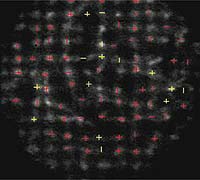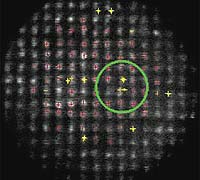Wavefront is valid, accurate way to assess refraction
The technology compares well to manifest refraction. It measures at least lower order aberrations well.
Click Here to Manage Email Alerts
SAN DIEGO — Wavefront technology using a Hartmann-Shack system can be validated by conventional clinical measures, at least for lower order aberrations, according to Steven C. Schallhorn, MD.
He and colleagues at the Navy Medical Center here sought the best way to interpret sphere, cylinder and axis from the Hartmann-Shack sensor used in the WaveScan Wavefront System (Visx, Santa Clara, Calif.).
Within the WaveScan system, the Hartmann-Shack sensor breaks down rays of light into packets. A lens array focuses each packet onto a charge-coupled device, which turns light into digital images. The Hartmann-Shack sensor then measures where the packet comes into focus on the charge-coupled device.
“By analyzing the exact position of where each packet focuses onto the charge-coupled device, you can reconstruct the wave that was entering the lens array,” Dr. Schallhorn said. “By analyzing the shape of the wave, you can determine the aberrations that were caused by the eye that it came out of.”
The technology is new, so researchers wanted to examine the level of agreement between the WaveScan System and conventional clinical refractive measures to quantify its accuracy.
Wavefront explained
 ---Hartmann-Shack
images were rejected for a number of reasons. In this image a vertex
reflection from a poorly centered eye is seen.
---Hartmann-Shack
images were rejected for a number of reasons. In this image a vertex
reflection from a poorly centered eye is seen.
Researchers
conducted bench testing on the WaveScan System for accuracy and then validated
results by comparing them with patients’ manifest refraction results.
“You can measure the lower-order aberrations [sphere and cylinder] by refracting somebody and comparing it to the wavefront,” Dr. Schallhorn said. “That gives you some assurance that at least it’s measuring the lower order aberrations before you make the leap to what it’s showing on higher order aberrations. If it’s showing lower order aberrations accurately, then maybe it’s also showing higher order ones accurately.”
Researchers compared the manifest and cycloplegic refractions in 100 subjects. Each patient had normal or post-refractive surgery eyes correctable to at least 20/20 best spectacle-corrected visual acuity.
For the bench test, researchers compared 315 measurements of the sphere, cylinder and axis in a model eye. The mean for the sphere and the cylinder was essentially zero, Dr. Schallhorn said. The standard deviation was within 0.25 D.
Researchers then conducted clinical testing. They enrolled patients with no prior history of refractive surgery and otherwise healthy eyes.
All of the eyes were imaged and the images were independently graded for quality by a research team. Data from 178 of 234 eyes met the criteria. The first acceptable measurement of each eye was used for analysis.
Rejection criteria included images that had an obvious vertex reflection from a poorly centered image on the eyes, a poorly centered device over the eye itself and tear film breakup. Researchers also rejected images if two adjacent spots had to be interpolated by the computer.
Conclusions
 ---In this Hartmann-Shack
image, tear film breakup can be seen. The image was
rejected.
---In this Hartmann-Shack
image, tear film breakup can be seen. The image was
rejected.
Researchers concluded that the WaveScan system can be
validated by conventional clinical measures.
They reviewed wavefront images derived from 178 eyes to look at the difference between the manifest sphere and the wavefront unit.
The mean difference between those results was 0.02 D, and the standard deviation was 0.5 D. More than 75% were within 0.5 D of intended correction. The regression line had a slope of 1 and an intercept of zero, “which is obviously a very good accuracy result,” Dr. Schallhorn said.
The mean difference between the manifest cylinder and the wavefront unit was essentially zero, with a standard deviation of 0.25 D, Dr. Schallhorn said. More than 90% of eyes were within 0.5 D of intended correction.
Manifest axis accuracy compared to wavefront axis differed slightly, with a standard deviation of a little more than 12°, and about 75% of eyes were within 10º of the manifest.
“We found that the WaveScan measured refractive error with a reasonable level of accuracy. Certainly the lower order terms agree with manifest refraction,” he said. “We are using this study to further refine the system to further improve its image acquisition and data analysis.”
Further testing
 ---Two adjacent spots were
interpolated by the computer in this Hartmann-Shack image, again
leading to rejection of the image.
---Two adjacent spots were
interpolated by the computer in this Hartmann-Shack image, again
leading to rejection of the image.
Next, researchers are looking
at a more detailed analysis of higher order terms in correlation with quality
of vision. To accomplish this, they are analyzing a population of military
pilots.
Dr. Schallhorn said that manifest refraction is inherently different from that provided by the WaveScan System. The technology gives sphere and cylinder for an eye, but that may differ from a manifest refractive sphere and cylinder, he said.
“Wavefront technology is in its infancy,” he said. “We don’t know in which direction the technology will go or how it will work. It’s going to require a lot more research, but it has great potential.”
Dr. Schallhorn originally reported these results at this year’s American Society of Cataract and Refractive Surgery meeting.
For Your Information:
- Steven C. Schallhorn, MD, can be reached at the Navy Medical Center, Department of Ophthalmology, San Diego, CA 92134-5000; (619) 532-6702; fax: (619) 532-7272.
